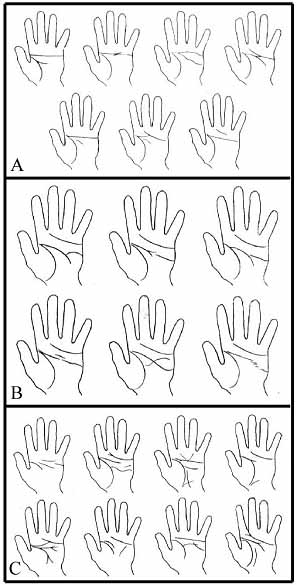- Hand Reading Mini-Course -
PSYCHOLOGY - Hyperactive children, simian line, Sydney crease & palm creases
INDEX (P1) - INTRO (P2) - HISTORY (P3-7) - DISEASES - (P8-13) - PSYCHIATRY (P14-25) - PSYCHOLOGY (P26-32) - CONCLUSION (P33-34)
![]()
Hand Diagnostics & Psychology:
hyperactive children, simian line, Sydney crease & palm creases!
From the seventies, several studies were conducted focussed on how developmental disorders relate to the characteristics of the human hand. Especially the work of Charles Felzen Johnson & Erica Opitz1,2 is significant in this perspective. They discovered e.g. that children who have developmental disorders, often have the characteristics of the simian line (see: figure D-2A) or the variants of the Sydney line (see: figure D-2B). However, often these children also have other abnormal characteristics in the hand lines - which were labeled by Johnson & Opitz as 'Type C'-lines (see: figure D-2C).
The etiology of this hand line defects is still considered as a 'mystery'. For, normally the primary lines development is independent from the other hand line. Nevertheless, in 1973 these researchers pronounced the following recommendation3:
"Inspection of palm creases should be a routine part of the pediatric physical examination"
Later, Johnson pointed to the fact that the defects in the lines do not have a SPECIFIC diagnostic value. These abnormalities can only be used as an "alerting signal".
In a study presented by Lerer3 both the simian crease and the Sydney line were more often found in the hands of 'hyperactive children' (about twice as often compared to the hands of 'normal' children).

Figure D-2: abnormal hand lines, simian line, simian crease, Sydney line, hyperactive children.
Sources:
1 - Johnson, C.F. & Opitz, E. (1971). The single palmar crease and its clinical significance in a child development clinic. Clinical Pediatrics, vol.10, no.7, p.392-403.
2 - Johnson, C.F. & Opitz, E. (1973). Unusual palm creases and unusual children: the Sydney line and 'Type C' palmar lines and their clinical significance in a child development clinic. Clinical Pediatrics, vol.12, no.2, p.101-112.
3 - Lerer, R.J. (1977). Do hyperactive children tend to have abnormal palmar creases? Clinical Pediatrics, vol.16, no.7, p.645-647.
A brand new masterclass in scientific hand reading is also available here:
Decoding The Language of The Hand:
how to find 36 conditions with just 54 major hand signs!
Common used synonyms for hand reading are: palmistry - palm reading - hand analysis - chirology - chiromancy - chirognomy